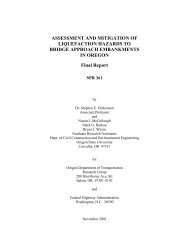Oregon Balance of State HIV/AIDS Housing & Services Systems ...
Oregon Balance of State HIV/AIDS Housing & Services Systems ...
Oregon Balance of State HIV/AIDS Housing & Services Systems ...
You also want an ePaper? Increase the reach of your titles
YUMPU automatically turns print PDFs into web optimized ePapers that Google loves.
52 <strong>Oregon</strong> <strong>HIV</strong>/<strong>AIDS</strong> <strong>Housing</strong> and <strong>Services</strong> <strong>Systems</strong> Integration Plan<br />
service providers, advocacy groups, and community- and faith-based organizations. Select a few<br />
agencies that are either receptive to partnership, represent significant resources in areas <strong>of</strong> need, or<br />
both to develop and pitch specific potential joint ventures. Successful early partnerships with<br />
housing providers can serve as examples for future collaborations in other regions <strong>of</strong> the state.<br />
7. Seek housing development opportunities in which relatively modest <strong>HIV</strong>/<strong>AIDS</strong>-specific<br />
resources can leverage significant investment from other sources.<br />
Steering Committee members underscored that even modest commitments <strong>of</strong> funding for operating<br />
costs and supportive services in affordable housing development applications can be persuasive to<br />
government funders. For example, in one case, just $35,000 allocated by the Division <strong>of</strong> Addictions<br />
and Mental Health for housing development has leveraged $1.5M in <strong>Oregon</strong> <strong>Housing</strong> and<br />
Community <strong>Services</strong> (OHCS) funds.<br />
Given the limited resources available for <strong>HIV</strong> Care and Treatment and OHOP, focus development<br />
or rehabilitation partnerships on units integrated into buildings (rather than stand-alone units).<br />
Promote set-asides for tenants living with <strong>HIV</strong>/<strong>AIDS</strong> who already receive case management and<br />
services, and thus are unlikely to create challenges or administrative costs for property managers.<br />
Homeless <strong>Services</strong><br />
8. Focus attention on improving coordination with planning, data, and other elements <strong>of</strong><br />
homeless systems.<br />
Connect with, and track the activities <strong>of</strong>, the state Ending Homelessness Advisory Council (EHAC).<br />
Participate regularly in Continuum <strong>of</strong> Care and state and local 10-Year Plan processes, using<br />
strategies described in the previous sections. Seek integration <strong>of</strong> data at the client level by linking<br />
information systems across mental health, <strong>HIV</strong> care, and homeless services, including partnering<br />
with OHCS to compare OHOP and <strong>HIV</strong>/<strong>AIDS</strong> epidemiology data with homeless services<br />
information.<br />
9. Promote Shelter Plus Care and other bonus projects through agreements to streamline<br />
or share sponsor administrative costs.<br />
Seek to allay the concerns <strong>of</strong> Continuum <strong>of</strong> Care partners and potential sponsors <strong>of</strong> “bonus” projects<br />
for serving chronically homeless people through coordinated planning to share administrative<br />
responsibilities. OHOP cannot allocate additional overhead above the administrative percentage<br />
allowed by its grants, but coordination between OHOP staff and partners may create efficiencies. If<br />
successful, initial partnering with existing Shelter Plus Care (S+C) providers can enhance and<br />
demonstrate the capacity <strong>of</strong> OHOP staff to seek additional S+C projects with new partners.<br />
10. Conduct outreach and seek partnerships with landlords and property managers.<br />
Link with regional housing centers that conduct fair housing and other trainings for landlords and<br />
potential landlords (including faith-based organizations), to promote the inclusion <strong>of</strong> information on<br />
the housing challenges and resources available to people living with <strong>HIV</strong>/<strong>AIDS</strong>. Effectively use<br />
existing tenant certification programs, such as St. Vincent de Paul’s Second Chance renter<br />
rehabilitation program, that connect landlords to tenants who have completed certification. Explore<br />
opportunities to create or participate in a landlord risk mitigation fund for clients who have histories<br />
<strong>of</strong> homelessness or other risk factors.

















